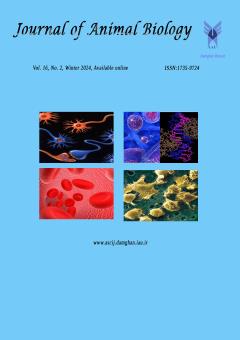Investigating the Destructive Effects of the Energizing Drug Oxymetholone on the Liver Tissue of NMRI Female Mice
Subject Areas : Journal of Animal BiologyNaeimeh Dehghani 1 , Hamed Danesh Pajooh 2
1 - Department of biology, Payame Noor University, Tehran, Iran
2 - Department of biology, Payame Noor University, Tehran, Iran
Keywords: Energizing Drug, Oxymetholone, Steroid, Liver, Mice,
Abstract :
Oxymetholone is an oral active anabolic-androgenic steroid. This drug was obtained in 1959 by methylating the 17α carbon and saturating the 5α carbon of testosterone. This drug in low doses are used to treat diseases such as; Anemia, lack of growth in children, reducing the spread of the AIDS virus in the body and heart failure are used. Unfortunately; some athletes use this drug as an energy-boosting drug in high doses due to its anabolic properties and its effect on muscle growth. In this study, the effect of Oxymetholone in a dose much higher than the physiological limit of the body was investigated on the liver of NMRI female mice. For this purpose, 12 mg/kg/day of the drug was injected intraperitoneally to adult mice (45 days old) for ten days. The results obtained from intraperitoneal (IP) injection of oxymetholone on the number of Kupffer cells in the liver in adult rats (NMRI) show that the number of Kupffer cells increased, which is significant at P<0.001. Also, according to the histograms related to The number of liver hepatocyte cells, the diameter of liver hepatocyte cells and the number of double nuclei in the liver and the results obtained, it can be seen that there is no significant difference in the comparison between the sham, control and experimental groups at P<0.05. The results of the present study show that the consumption of oxymetholone steroids can cause harmful effects on the liver tissue of athletes.
1. Azarnia M., Daneshpajoh H., Dehghani N. 2007. Investigating the effects of oxymetholone in doses much higher than the physiological limit on the oogenesis of female mice, NMRI breed. Journal of Qom University of Medical Sciences, 1(1):37-43.
2. Chahla E., Hammami M., Befeler A. 2014. Hepatotoxicity associated with anabolic androgenic steroids present in over-the-counter supplements: A case series: 420. Official journal of the American College of Gastroenterology| ACG, 41:179-183.109:126.
3. El-Serag H.B. 2004. Hepatocellular carcinoma: recent trends in the United States. Gastroenterology, 127(5):27-34.
4. Fredrigue Z., Williem Den Besten, Bo Chen, J.E., Esther L. 2001. Control of spermatogenesis in mice by the cyclin D-dependent kinase inhibitors P18Ink42 and P19Ink4d. Molecular and Cellular Boilogy, 21(9):3244-3255.
5. Kuipers H. 1998. Anabolic steroids: side effects. Encyclopedia of sports medicine and science. Internet Society for Sport Science.
6. Neri M., Bello S., Bonsignore A., Cantatore S., Riezzo I., Turillazzi E., Fineschi V. 2011. Anabolic androgenic steroids abuse and liver toxicity. Mini reviews in Medicinal Chemistry, 11(5):430-437.
7. Nourozi J., Mahdavi Mazdeh M., Mirbagheri S.A. 2014. The effects of the underlying disease and serum albumin on GFR prediction using the adaptive neuro fuzzy inference system (ANFIS). Health Management and Information Science, 1(3):46-50.
8. Rajagopal R., Subbiah P. 2014. Computer aided detection of liver tumor using SVM classifier. International Journal of Advanced Research in Electrical, Electronics and Instrumentation Engineering, 3(6):10170-10177.
9. Ranjbar B., Poraboli I. 2014. The Effect of Daucus carota ssp. sativum seeds extract on serum levels of renal function indicators and liver function enzymes in type I diabetes model. Journal of Sabzevar University of Medical Sciences, 21(3):370-378.
10. Rashid Lamir A., Dehbashi M., Ketabdar B. 2016. Examination of effects of anabolic steroids abuse on liver enzymes and blood albumin of bodybuilders. Journal of Sabzevar University of Medical Sciences, 23(1):6-13.
11. Robles‐Diaz M., Gonzalez‐Jimenez A., Medina‐Caliz I., Stephens C., García‐Cortes M., García‐Muñoz B., Ortega‐Alonso A., Blanco‐Reina E., Gonzalez‐Grande R., Jimenez‐Perez M., Rendón P. 2015. Distinct phenotype of hepatotoxicity associated with illicit use of anabolic androgenic steroids. Alimentary Pharmacology and Therapeutics, 41(1):116-125.
12. Schwingel P.A., Cotrim H.P., Salles B.R., Almeida C.E., dos Santos Jr C.R., Nachef B., Andrade A.R., Zoppi C.C. 2011. Anabolic‐androgenic steroids: A possible new risk factor of toxicant‐associated fatty liver disease. Liver International, 31(3):348-353.
13. Stickel F, Kessebohm K, Weimann R, Seitz HK. 2011. Review of liver injury associated with dietary supplements. Liver International, 31(5):595-605.
14. Timcheh-Hariri A., Balali-Mood M., Aryan E., Sadeghi M., Riahi-Zanjani B. 2012. Toxic hepatitis in a group of 20 male body-builders taking dietary supplements. Food and Chemical Toxicology, 50(10):3826-3832.
15. Torabyan A., Falahatkar B., Khoshkholgh M. 2019. The effect of dietary oxymetholone on growth, survival and reproduction of guppy (Poecilia reticulata). Journal of Aquaculture Development, 13(2):15-28.
16. Urhausen A., Torsten A., Wilfried K. 2003. Reversibility of the effects on blood cells, lipids, liver function and hormones in former anabolic–androgenic steroid abusers. The Journal of Steroid Biochemistry and Molecular Biology, 84(2-3):369-75.


